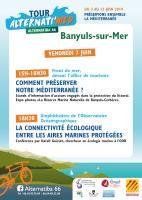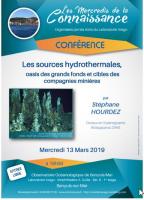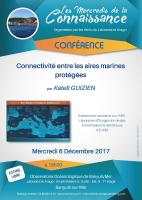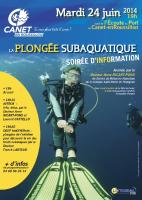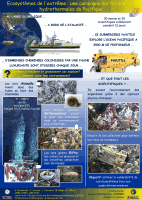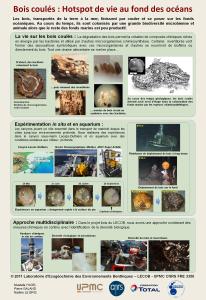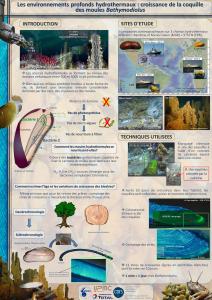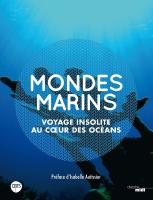 Benthic Ecogeochemistry Laboratory
UMR 8222
Benthic Ecogeochemistry Laboratory
UMR 8222
Events: Conferences & Exhibitions
|
2019 | |
|---|---|
|
|
Katell Guizien, Directrice de recherches au CNRS a présenté le 7 juin 2019 une conférence intitulée
Connectivité des Aires Marines Protégées
A l’instar des réseaux informatiques et des réseaux sociaux, les aires marines protégées, mises en place sur un discours de bénéfices pour les communautés humaines locales, sont incitées à se mettre en réseau. Mais de quel réseau parle-t-on ? Quelle est cette trame bleue marine de connectivité, invisible ou presque depuis les satellites, qui permettrait d’optimiser la protection du milieu marin ? A quelles échelles spatiales faudra t’il promouvoir les solidarités écologiques autour de la biodiversité marine ?
|
|
|
Sétphane Hourdez, Chargé de recherches au CNRS a présenté le 13 mars 2019 une conférence intitulée
Les sources hydrothermales, oasis des grands fonds et cibles des compagnies minières.
|
|
2017 | |
|---|---|
|
|
Katell Guizien, Directrice de recherches au CNRS a présenté le 6 décembre 2017 une conférence intitulée
Connectivité des Aires Marines Protégées
A l’instar des réseaux informatiques et des réseaux sociaux, les aires marines protégées, mises en place sur un discours de bénéfices pour les communautés humaines locales, sont incitées à se mettre en réseau. Mais de quel réseau parle-t-on ? Quelle est cette trame bleue marine de connectivité, invisible ou presque depuis les satellites, qui permettrait d’optimiser la protection du milieu marin ? A quelles échelles spatiales faudra t’il promouvoir les solidarités écologiques autour de la biodiversité marine ? |
|
2015 | |
|---|---|
|
Katell Guizien, Chargée de recherches au LECOB a présenté le 2 octobre 2015 une conférence intitulée "Les espèces marines fixées et leur rapport avec la conservation et le cycle de vie avec le corail rouge comme exemple". Cette conférence s'est faite dans le cadre du 15ème Éco-Festival, La Méditerranée, une mer vivante qui a eu lieu à Céret (Pyrénée-Orientales) du 30 septembre au 4 octobre 2015. |
|
|
2014 | |
|---|---|
|
Franck Lartaud, Maître de conférences au LECOB (UPMC) a présenté une conférence intitulée : "Deep Biodiversity : Plongées de l'extrême pour découvrir la faune des fonds océaniques" dans le cadre d'une soirée d'information sur la plongée subaquatique à Canet en Roussillon le 24 juin 2014. La soirée était animée par le Docteur Anne Ricart-Pons du service de médecine hyperbare de la clinique Saint-Pierre de Perpignan avec la participation de la ville de Canet, le club de plongée canetois et Aquatile Plongée. |
|
|
2013 | |
|---|---|
|
|
13 juin : "A la découverte d’un géant invisible" ou l’écologie du phytoplancton. Conférence par François Lantoine, Maître de Conférences à l'UPMC (LECOB)
Les océans couvrent les deux tiers de la surface du globe mais de très nombreux organismes vivants restent inconnus. Parmi ceux-ci, le phytoplancton constitué d’algues microscopiques unicellulaires flottant au grès des courants constitue un mystère pour le plus grand nombre. Chaque goutte d’eau des premiers cent mètres de l’océan contient des milliers de représentants d’une flore invisible à l’œil nu. Ces microalgues présentes dans tous les océans et mers du monde forment une gigantesque « forêt planctonique » invisible. Étant à la base des chaînes alimentaires marines, le phytoplancton joue un rôle essentiel dans l’écologie des océans et plus largement dans le cycle du carbone à l’échelle de la planète. Cette conférence grand public a pour objectif de présenter de manière simple : la diversité, l’écologie et la beauté de ces lilliputiens des mers. |
- Exposition "les yeux de la mer" 2014
⁃ Exposition Les Yeux de la Mer, Nice 2014. Atelier Milieux Profonds L’INVISIBLE DEVIENT VISIBLE : LES MILIEUX EXTRÊMES. Organisée par Karine Nedoncelle sous la responsabilité de Nadine Le Bris.
Karine Nedoncelle, ancienne doctorante du LECOB (2010-2013) a participé à l'exposition "Les Yeux de la Mer. Trois siècles d'Observation entre ART et Science" en animant le 16 août 2014 un atelier intitulé "l'invisible devient visible : les milieux extrêmes". Elle a présenté des spécimens de coraux et d'huîtres de milieu profond ainsi que des photos prélevés et prises au cours des différentes missions océanographiques du programme "Canyon de Lacaze-Duthiers" de la chaire UPMC-Fondation Total. Cet atelier s'est fait avec le soutien de Franck Lartaud, Maître de Conférences à l'UPMC et de Nadine Le Bris, Professeur à l'UPMC et Directrice du LECOB. Cette exposition (20 juin au 31 décembre 2014) a eu lieu au Parc Phoenix à Nice.
Pour en savoir plus : www.ydlm.fr.
- Fête de la Science 2012
Écosystèmes de l'extrême
Présentation des écosystèmes de l'extrême lors de la fête de la science 2012 sur 2 posters présentant les sources hydrothermales du Pacifique. Participation : K. Nedoncelle . F. Lartaud . L. Contreira . M. Yücel . N. LeBris
![]() 2 posters présentent ces recherches sur les sources hydrothermales. : poster 1 et poster 2
2 posters présentent ces recherches sur les sources hydrothermales. : poster 1 et poster 2
- Fête de la Science 2011
Croissance en environnement profond
Lors des journées portes-ouvertes du Laboratoire Arago, Le LECOB a présenté le 15 octobre 2011 ses travaux sur l'étude des environnements profonds. Coordination: Franck Lartaud, Participation: Karine Nédoncelle (doctorante), Mustafa Yücel (post-doc) et Nadine de Bris.
En s’appuyant sur des espèces clés de la biodiversité dans les milieux extrêmes (coraux blancs dans les canyons, moules des sources hydrothermales), le présent projet vise à illustrer au grand public les thématiques de recherche développées au sein du Laboratoire d’Ecogéochimie des Environnements Benthiques (LECOB) de l’Université Pierre et Marie Curie et du CNRS à l’Observatoire Océanologique de Banyuls, sur la croissance des organismes calcifiants en relation avec la variabilité de leur environnement (cascades d’eau dense, émissions de fluides hydrothermaux).
![]() 3 posters présentent les activités de recherche en mer et en laboratoire. (Cliquez sur chacun des posters pour les agrandir).
3 posters présentent les activités de recherche en mer et en laboratoire. (Cliquez sur chacun des posters pour les agrandir).
Books & chapters
|
Les Mondes Marins. (2014). Édition du Cherche Midi Éditeur, Institut Écologie Environnement du CNRS. Nadine Le Bris, Professeur et directrice du LECOB est l'auteur et la coordinatrice des chapitres : ‘Les yeux sous la mer’ et ‘Les animaux de l’extrême’. |
|
Éditeur, Institut Écologie Environnement du CNRS.
Pierre Galand, chercheur CNRS au LECOB, a participé en tant qu'auteur à l'ouvrage grand public "Mondes Polaires, Homme et biodiversité, Des défis pour la science". Ce livre est un ouvrage collectif sur les régions polaires sous la direction de Mireille Raccurt et Robert Chenorkian, avec une préface du Prince Souverain Albert II de Monaco. Le livre est issu des prospectives de l'INEE (avant-propos de Françoise Gaill). Pour en savoir plus "MONDES POLAIRES |
Lectures, Posters, Seminars
![]() talk
talk ![]() poster
poster
|
2017 |
|---|
|
|
|
|
|
|
|
|
|
|
|
2016 |
|---|
|
|
|
|
|
|
|
|
|
|
|
|
|
2015 |
|---|
|
|
|
Costa A., Doglioli A., Guizien, K, Petrenko A. (2015). Estimation of connectivity in marine biological networworks: graph theory versus metapopulation models. An application to the Gulf of Lion. ASLO 2015 Aquatic Siencess MeetingNouvelle fenêtre" Global And Regional Perspectives. North Meets South. 22 au 27 février 2015. Grenade, Espagne. |
|
|
|
|
|
|
|
|
|
|
|
|
|
|
|
|
|
|
|
|
|
|
|
|
|
Padron, M., Baksay, S., Bramanti, L., Costantini, F., Guizien, K. Connectivity of white gorgonian populations in the Gulf of Lions: observed versus modelled genetic structure. ASLO 2015 Aquatic Siencess Meeting. Global And Regional Perspectives. North Meets South du 22 au 27 février 2015. Grenade, Espagne. |
|
|
|
|
|
2014 |
|---|
|
|
|
Bramanti L. (2014) : Landscape versus seascape: the ecogeochemical approach in the gorgonians forest. colloque "Écologies marines et continentales". Société Française d’Écologie, CNRS, Université Pierre et Marie Curie. Paris, France, 7 et 8 janvier 2014. |
|
|
|
|
|
|
|
|
|
Guizien G. (2014) : Spatially structured connectivity: using fluid dynamics to predict propagules dispersal in the ocean, why not in air ? colloque "Écologies marines et continentales". Société Française d’Écologie, CNRS, Université Pierre et Marie Curie. 7 et 8 janvier 2014. Paris, France, |
|
|
|
|
|
|
|
|
|
|
|
|
|
|
|
|
|
Pruski A. (2014) : Apports pulsés de matière organique particulaire en Méditerranée NO: influence des crues du Rhône sur l’écosystème benthique. colloque "Écologies marines et continentales". Société Française d’Écologie, CNRS, Université Pierre et Marie Curie. 7 et 8 janvier 2014, Paris, France, . |
|
|
|
|
|
|
|
|
|
|
|
|
|
|
|
2013 |
|---|
|
|
|
|
|
|
|
|
|
|
|
|
|
Guizien K. (2013) :Metapopulation modelling based on larval dispersal simulations to study benthic species resilience to extreme climatic and anthropogenic stresses. ASLO 2013 Aquatic Siencess Meeting, Learning for the future". 17 au 22 février 2013, La Nouvelle Orléans, Louisiane, États-Unis. |
|
|
|
|
|
|
|
|
|
|
|
Lucas S. (2013) : Oscillating grid mesocosm for studying oxygen dynamics during unsteady turbulent conditions. ASLO 2013 Aquatic Siencess Meeting, Learning for the future". 17 au 22 février 2013, La Nouvelle Orléans, Louisiane, États-Unis. |
|
|
|
|
|
|
|
|
|
Sardá, R., Serrano, L., Labrune, C., Gil, J., March, D., Amouroux, J-M., Taboada, S., Bonifacio, P., Grémare, A. Shallow-water pol ychaete assemblages in the Northwestern Mediterranean Sea and its possible use in the evaluation of good environmental state. 11th international Polychaete Conference Proceedings. 4-9 août , 2013, Sydney, Australie. |
|
|
|
|
|
|
|
2012 |
|---|
|
|
|
|
|
2011 |
|---|
|
http://meetingorganizer.copernicus.org/EGU2011/oral_programme/7029
|
| |
|
|
|
|
|
|
|
http://meetingorganizer.copernicus.org/EGU2011/poster_programme/7030 |
|
|
|
|
|
|
|
|
|
http://meetingorganizer.copernicus.org/EGU2011/oral_programme/7029 |
|
2010 |
|---|
|
Bellamy E., Mahé K., de Rafelis M., Lartaud F. (2010). Growth of the common cockle Cerastoderma edule: validation of the periodicity of increment deposition by calcein marker. 2nd International Sclerochronology Conference. 24 au 28 juillet 2010, Mainz, Allemagne. |
|
Bourgeois S, Pruski A.M., Buscail R., Charles F., Lantoine F., Vétion G., Rivière B, Desmalades M. (2010). Influence of a flood event on the composition of organic matter from prodeltaic sediments (Rhône prodelta, France). RST 2010 Bordeaux, 23ème Réunion des Sciences de la Terre. 25-27 octobre 2010, Bordeaux, France. |
|
Bourgeois S., Ghiglione J.-F., Lantoine F., Desmalades M., Escoubeyrou K., Vétion G., Rivière B., Charles F., Pruski A.M. (2010). Caractéristiques de la MO dans un environnement deltaïque : Le prodelta du Rhône (Golfe du Lion, France) pendant un évènement de crue : Relation avec la structure des communautés bactériennes. Réunion finale du Programme CHACCRA, 18-20 janvier 2010, Gif-sur-Yvette, France |
|
Cathalot, C., Buscail, R., Pruski, A., Pastor, L., Rabouille, C. (2010). From transient to stationary benthic mineralization activity in the Rhône river prodelta: Temporal monitoring of flood deposit. AGU Vienne. Vienne, Autriche. |
|
|
|
Chatelain M., Guizien K. (2010). Low-frequency flow control on oxygen dynamics near the sediment-water interface. Poster, Benthic Ecology Meeting, , 12-13 mars 2010, Wilmington (NC), États-Unis. |
|
Dupuy C., Guizien K., Mallet C., Montanie H., Ory P., Orvain F. (2010). Benthic-pelagic coupling: biofilm erosion and resuspension of micro-organisms in the Brouage mudflat (French Atlantic Coast). Benthic Ecology Meeting. 12-13 mars 2010, Wilmington (NC), États-Unis. |
|
|
|
|
|
Lartaud F., Little C.T.S., de Rafelis M., Bayon G., Ildefonse B., Dyment J., Le Bris N. (2010). Fossil bivalves in the Rainbow area: new insight into the diversity and evolution of chemosynthetic communities. Chapman Conference. 8 au16 mai 2010, Agros, Chypre. |
|
Le Callonnec L., Lartaud F., de Rafelis M., (2010). Trace elements and stable isotopes from unionid bivalve shells: proxy records of environmental conditions and pollution events. Experimental approaches in situ (Ile-de-France) and in laboratory. 2nd International Sclerochronology Conference. 24-28 juillet 2010, Mainz, Allemagne. |
|
Chatelain M., Guizien K. (2010). Low-frequency flow control on oxygen dynamics near the sediment-water interface. Benthic Ecology Meeting. 10 mars 2010, Wilmington, NC., États-Unis. |
|
Mouchi V., Lartaud F., de Rafelis M., (2010). Environmental vs. physiological control of the Mg/Ca and Sr/Ca distribution in oyster shells. 2nd International Sclerochronology Conference. 24-28 juillet 2010, Mainz, Allemagne. |
|
|
|
Pruski A.M., Bourgeois S., Escoubeyrou K., Desmalades M., Vétion G., Rivière B., Lantoine F., Charles F., Buscail R. and Sun M.Y (2010). Benthic remineralisation of terrestrial and marine organic matter and its temporal variation in the Rhône prodelta and adjacent shelf: Evaluation of the origin and quality of sedimentary organic matter using biochemical proxies. Réunion finale du Programme CHACCRA. 18-20 janvier 2010, Gif-sur-Yvette, France. |
|
Rabouille, C., Estournel, C., POC, Naudin, J. J., Radakovitch, O., CEREGE, Raimbault, P., Buscail, R., Deflandre, B., Fontanier, C., Pruski, A., Bassoulet, P. (2010). The fate of Rhône river carbon and nutrients in the coastal Mediterranean sea and its relation to climatic parameters. CIESM 2010, Venise, Italie. |
|
|
|
Yücel M, Contreira L, Le Bris N. (2010). ‘Autonomous voltammetry at deep-sea hydrothermal vents’. Oral presentation given in 15th Cross-Border Meeting of Sensors and Biosensors. 17 septembre 2010, Sant Carles de la Rapita, Espagne. |
News & magazines
- Article dans le journal Corse matin du 3 mai 2018
Des scientifiques du CNRS en mission au port de Toga.
- Article dans le journal l'Écho du Roussillon du 2 avril 2014
Le taret, ancien fléau, acteur de biodiversité
Présentation des travaux de François Charles, chargé de recherches au CNRS, sur le taret.
- Article dans le Journal l'Indépendant du 25 février 2014)
Le taret : un ancien fléau au service de l'écologie moderne
Un article dans l'Indépendant publié le 25 février 2014, présente les recherches menées par François Charles (chargé de recherche au CNRS), François Lantoine (Enseignant-chercheur à l'UPMC), Jean-Marc Guarini (Professeur à l'UPMC) et Sandrine Fanfard (doctorante UPMC) sur un petit bivalve xylophage, le taret (teredo navalis).
- Article dans le journal Sciences Daily, rubrique "Sciences News", le 18 novembre 2013
Small Thaw Ponds: An Unaccounted Source of Methane in the Canadian High Arctic
Karita Negandhi, Isabelle Laurion, Michael J. Whiticar, Pierre E. Galand, Xiaomei Xu, Connie Lovejoy. . PLoS ONE, 2013; 8 (11)
- Article dans le journal Sciences Daily, rubrique "Sciences News", le 10 septembre 2013
Why are some corals flourishing in a time of global warning?
Cet article présente les travaux d'un projet financé par le National Science Foundation (NSF) auxquels participe Lorenzo Bramanti, post-doc au LECOB.
- Communiqué de presse régionale Monpellier, le 4 avril 2013
"Des microorganismes insoupçonnés dévoilent leur rôle dans le maintien de la biodiversité marine"
Lire le communiqué
Il y a près de 40 ans, la découverte d’un troisième « domaine » d’êtres vivants bouleversait notre vision de la biodiversité. De nos jours, ces microorganismes appelés Archaea sont loin d’avoir livré tous leurs secrets. Deux laboratoires de Banyuls-sur-Mer, le Laboratoire d’écogéochimie des environnements benthiques (LECOB – UPMC/CNRS) et le Laboratoire d’océanographie microbienne (LOMIC – UPMC/CNRS), viennent de participer à une étude1 qui dévoile la composition de cette population microscopique et son rôle probablement important dans l’équilibre des écosystèmes. Ces résultats ont fait l’objet d’une publication dans la revue internationale PNAS le 25 mars.
Mylène Hugoni & Najwa Taib, Didier Debroas, Isabelle Domaizon, Isabelle Jouan Dufournel, Gisèle Bronner, Ian Salter, Hélène Agogué, Isabelle Mary, and Pierre E. Galand. « Structure of the rare archaeal biosphere and seasonal dynamics of active ecotypes in surface coastal waters”, in Proceedings of the National Academy of Sciences USA, 25 mars 2013. Doi : 10.1073/pnas.1216863110. Contacts Contact-chercheur | LECOB | Pierre Galand | T. 04 30 19 24 14 | This email address is being protected from spambots. You need JavaScript enabled to view it. Communication | CNRS | Aurélie Lieuvin | T. 04 67 61 35 10 | This email address is being protected from spambots. You need JavaScript enabled to view it.
- Article dans "La Provence" du jeudi 10 novembre 2011 sur le colloque Biodivmex du CNRS qui s'est tenu à Marseille.
Trois membres du LECOB ont participé à l'atelier BIODIVMEX sur la biodiversité en Méditerranée du chantier MISTRAL. Cet atelier vise à préparer un livre blanc permettant de faire le point sur les recherches concernant la biodiversité conduites dans le bassin méditerranéen. Il a aussi pour objectif de participer à la structuration de la communauté internationale et d'envisager des recherches coopératives prioritaires dans le domaine.
Participants : Nadine Le Bris, Céline Labrune et Mustafa Yücel.
"Des jardins de roses au fond de l'océan".
« Jardin de roses », c'est ainsi qu'on a nommé la première source hydrothermale découverte. Ce nom traduit la surprise des explorateurs face au foisonnement de vie qu'elle héberge. En effet, de multiples organismes prospèrent dans ces oasis du fond des océans, grâce à une chimie du vivant inédite qui n'est pas inféodée à l'énergie du Soleil.
Nadine Le Bris, conseil scientifique pour la traduction de l'article : "Abysses : un empire méconnu" de Craig Mc Clain, directeur scientifique adjoint du Centre national de synthèse sur l'évolution de Durham, en Caroline du Nord aux États-Unis.
- "Une cité fantôme habitée" par Grégory Fléchet (interview de Nadine Le Bris et de Franck Lartaud). Lire page 11.
Géochimie : On pensait le site hydrothermal de Lost City incapable d’abriter une faune importante. L’étude de son double fossile prouve le contraire.
Journal du CNRS n°258-259 juillet-août 2011
Nature Geosciences : research highlights, volume 4 juin 2011

Article dans l'Indépendant du 22-05-11 (http://www.lindependant.fr/)
© 2025 LECOB


